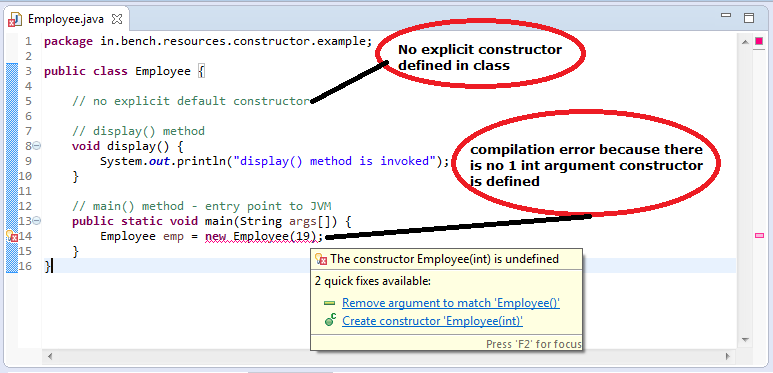

Like C++, Java also supports "Copy Constructor". All fields are left at their initial value of 0 (integer types), 0.0 (floating-point types), false (boolean type), or null (reference types). in Java, the default constructor implicitly calls the superclass's nullary constructor, then executes an empty body). In Java, a "default constructor" refer to a nullary constructor that is automatically generated by the compiler if no constructors have been defined for the class or in the absence of any programmer-defined constructors (e.g. It may initialize data members to zero or other same values, or it may do nothing at all. The behavior of the default constructor is language dependent.
#JAVA CONSTRUCTOR WITH ONLY PARAMETERS CODE#
You would not find it in your source code (the java file) as it would be inserted into the code during compilation and exists in. This constructor is known as default constructor. If the programmer does not supply a constructor for an instantiable class, Java compiler inserts a default constructor into your code on your behalf. The method of calling the constructor implicitly is also called the shorthand method.Įxample e = Example ( 0, 50 ) // Explicit call. The constructors can be called explicitly or implicitly. The normal way of object declaration may not work. When an object is declared in a parameterized constructor, the initial values have to be passed as arguments to the constructor function. Types Parameterized constructors Ĭonstructors that can take at least one argument are termed as parameterized constructors. Constructors, which concretely use a single class to create objects and return a new instance of the class, are abstracted by factories, which also create objects but can do so in various ways, using multiple classes or different allocation schemes such as an object pool. Some languages take consideration of some special types of constructors. Most languages allow overloading the constructor in that there can be more than one constructor for a class, with differing parameters. Immutable objects must be initialized in a constructor. A properly written constructor leaves the resulting object in a valid state. They have the task of initializing the object's data members and of establishing the invariant of the class, failing if the invariant is invalid. Constructors often have the same name as the declaring class. It prepares the new object for use, often accepting arguments that the constructor uses to set required member variables.Ī constructor resembles an instance method, but it differs from a method in that it has no explicit return type, it is not implicitly inherited and it usually has different rules for scope modifiers. In class-based, object-oriented programming, a constructor (abbreviation: ctor) is a special type of function called to create an object.


 0 kommentar(er)
0 kommentar(er)
